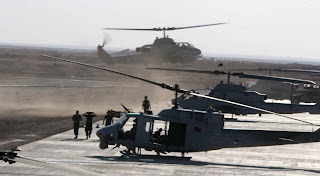
CAMP MEJID, Iraq - Marines with Marine Wing Support Squadron 172 wrapped up a basic electrical skills training course for Iraqi Army engineers at Camp Mejid Aug. 18.
The 14-day course, taught by the 3rd Marine Aircraft Wing (Forward) support squadron, covered the fundamentals of interior wiring and grounding techniques.
Through the course, the Marines provided the Iraqi soldiers with basic electrical skills that will help the soldiers improve the safety and function of IA facilities.
The training provided essential knowledge needed to safely ground electrical power sources, how to properly determine what type of electrical load is needed and how to distribute power evenly, explained Staff Sgt. Shane Munoz, the lead instructor of the class.
The knowledge gained through the class is important, according to Munoz, as it empowers the Iraqi soldiers with the ability to fix high-risk situations caused by poorly wired electrical systems.

“It was good to see the interaction with the Iraqi Army and see they were interested in what was being taught,” said Munoz. “It was an enlightening experience.”
When the classes ended, the Iraqi engineers moved quickly to begin their first projects – rewiring a building and restoring a generator to full capabilities.
Under the supervision of the Marines, the Iraqis successfully repaired the generator and upgraded the building, resulting in a significantly improved working environment.
“These guys are great,” said Lance Cpl. Amanda Gambill, a generator mechanic. “They were always open to my suggestions in order to learn. Furthermore, they were always willing to jump in there and do it themselves.”
Marine electricians participate in three months of vigorous studies and hands-on training before heading to the operating forces. Compressing those three months of training into a fourteen-day course with the added challenge of a language barrier tested the mettle of Chief Warrant Officer 2 Charles Hart and the Marines of MWSS-172’s utilities section.
As the utilities officer, Hart pulled key concepts for grounding and wiring from the three-month curriculum. He worked with Munoz to ensure the course would provide the Iraqi soldiers with the basic skills required to allow them to immediately improve the safety of their work space. The skills learned also have applicability in the Iraqi civilian job market.

“The training was excellent. My soldiers learned a lot about electricity that they didn’t know before,” said 2nd Lt. Fawzi Ahmed, commander, Support Platoon Commander, Engineer Regiment, 7th Infantry Division.
“They had tools but didn’t know how to use them. They had no clue about phases of electricity. In the future they will be able to solve problems and fix electricity for the division,” he added, referring to the Iraqi Army’s 7th Infantry Division which his platoon supports.
Colonel Daniel Elzie, commanding officer, Marine Wing Support Group 37, 3rd Marine Aircraft Wing, described the training as “very important” and noted that the training provided a unique opportunity to further enhance the relationship between the Marine Corps and the Iraqis.
After the classes ended and electrical repairs were completed, it was all smiles and handshakes between the Marines and Iraqi soldiers, but Hart noted that this wasn’t the last time the squadron would provide electrical training to the Iraqis. Additional classes are scheduled throughout the remainder of the squadron’s deployment.
“Our end goal with this training is to ensure the Iraqis have a solid foundation of electrical skills so that they can maintain and grow their facilities,” said Hart. “Being able to manage their logistical infrastructure is a huge step toward independence for them. Electricity is a key element of this infrastructure.”













.jpg)
.jpg)
.jpg)
.jpg)
.jpg)
.jpg)
.jpg)
.jpg)
.jpg)













.jpg)
.jpg)


.jpg)
.jpg)
.jpg)
.jpg)